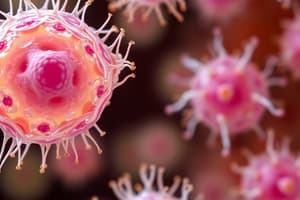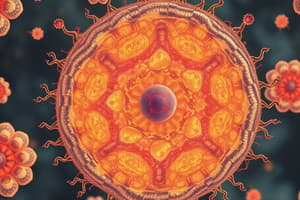Podcast
Questions and Answers
What is the main function of lysosomes in a cell?
What is the main function of lysosomes in a cell?
- Protein synthesis
- Storage of nutrients
- Breaking down waste materials (correct)
- Energy production
Which statement accurately describes the cell membrane?
Which statement accurately describes the cell membrane?
- It is composed solely of proteins
- It is a rigid structure that protects the cell
- It does not regulate entry or exit of substances
- It is selectively permeable (correct)
Which of the following is true regarding vacuoles in plant and animal cells?
Which of the following is true regarding vacuoles in plant and animal cells?
- Plant cells typically have a large central vacuole (correct)
- Vacuoles are the primary site of photosynthesis
- Vacuoles are absent in animal cells
- Vacuoles are responsible for cellular respiration
What component primarily makes up the cell wall in plant cells?
What component primarily makes up the cell wall in plant cells?
Which of the following functions is performed by proteins embedded in the cell membrane?
Which of the following functions is performed by proteins embedded in the cell membrane?
What is the primary function of the plasma membrane?
What is the primary function of the plasma membrane?
Which of the following structures are found in eukaryotic cells but not in prokaryotic cells?
Which of the following structures are found in eukaryotic cells but not in prokaryotic cells?
What are mitochondria responsible for in the cell?
What are mitochondria responsible for in the cell?
What is the primary component that surrounds prokaryotic cells?
What is the primary component that surrounds prokaryotic cells?
Which type of endoplasmic reticulum is involved in protein synthesis?
Which type of endoplasmic reticulum is involved in protein synthesis?
The nuclear envelope is crucial for which function?
The nuclear envelope is crucial for which function?
Which structure helps prokaryotic cells adhere to surfaces?
Which structure helps prokaryotic cells adhere to surfaces?
What distinguishes eukaryotic cells from prokaryotic cells?
What distinguishes eukaryotic cells from prokaryotic cells?
Flashcards
Cell Membrane
Cell Membrane
A membrane that surrounds the cell, regulating what enters and leaves.
Phospholipid Bilayer
Phospholipid Bilayer
A flexible barrier made of two layers of phospholipids with embedded proteins.
Lysosomes
Lysosomes
Organelles that break down waste and cellular debris.
Ribosomes
Ribosomes
Signup and view all the flashcards
Cell Wall
Cell Wall
Signup and view all the flashcards
What are cells?
What are cells?
Signup and view all the flashcards
What is the plasma membrane?
What is the plasma membrane?
Signup and view all the flashcards
What is cytoplasm?
What is cytoplasm?
Signup and view all the flashcards
What are prokaryotic cells?
What are prokaryotic cells?
Signup and view all the flashcards
What are eukaryotic cells?
What are eukaryotic cells?
Signup and view all the flashcards
What is the nucleus?
What is the nucleus?
Signup and view all the flashcards
What are mitochondria?
What are mitochondria?
Signup and view all the flashcards
What is the endoplasmic reticulum (ER)?
What is the endoplasmic reticulum (ER)?
Signup and view all the flashcards
Study Notes
Cell Structure
- Cells are the fundamental units of all living organisms.
- Cells vary in shape and size according to their specific function.
- A cell's basic structure includes a plasma membrane, cytoplasm, and a nucleus (in eukaryotic cells).
- The plasma membrane controls the passage of materials into and out of the cell.
- Cytoplasm is the gel-like substance within the cell, containing organelles.
- Organelles are specialized structures performing specific functions.
Types of Cells
- Cells are classified as prokaryotic or eukaryotic.
- Prokaryotic cells are simpler and smaller than eukaryotic cells.
- Prokaryotes lack a nucleus and membrane-bound organelles.
- Bacteria and archaea are examples of prokaryotic cells.
- Eukaryotic cells are more complex and larger than prokaryotic cells.
- Eukaryotic cells have a nucleus and membrane-bound organelles (mitochondria, endoplasmic reticulum, Golgi apparatus).
- Animal cells and plant cells are examples of eukaryotic cells.
Prokaryotic Cell Structure
- Prokaryotic cells have a cell wall for structural support and protection.
- The cell wall surrounds the plasma membrane.
- Some prokaryotes have a capsule outside the cell wall, aiding in protection and adhesion.
- Prokaryotes have a singular, circular chromosome in a region called the nucleoid.
Eukaryotic Cell Structure
- Eukaryotic cells contain a nucleus that stores genetic material (DNA).
- The nucleus is enclosed by a nuclear membrane (nuclear envelope).
- The nuclear envelope is a double membrane with nuclear pores, vital for molecule transport.
- Cytoplasm fills the space between the nucleus and the cell membrane.
Cell Organelles
- Mitochondria are energy-generating organelles (ATP synthesis) through cellular respiration.
- Mitochondria contain their own DNA.
- The endoplasmic reticulum (ER) is a membrane network for protein and lipid synthesis.
- Rough ER, studded with ribosomes, is crucial for protein synthesis.
- Smooth ER, lacking ribosomes, is involved in lipid synthesis and detoxification.
- The Golgi apparatus modifies, sorts, and packages proteins and lipids.
- Lysosomes contain enzymes for breaking down waste and cellular debris.
- Ribosomes synthesize proteins; some are free in the cytoplasm, others bound to rough ER.
- Vacuoles are storage compartments, with plant cells often having a large central vacuole.
Cell Membrane
- The cell membrane is a phospholipid bilayer with embedded proteins.
- The phospholipid bilayer is selectively permeable, allowing specific substance passage.
- The cell membrane regulates the entry and exit of substances.
- Membrane proteins perform various roles (channels, pumps, receptors).
Cell Wall
- Plant cells, fungi, algae, and some bacteria have rigid cell walls.
- The cell wall provides structural support and protection.
- Plant cell walls are primarily composed of cellulose.
Studying That Suits You
Use AI to generate personalized quizzes and flashcards to suit your learning preferences.




